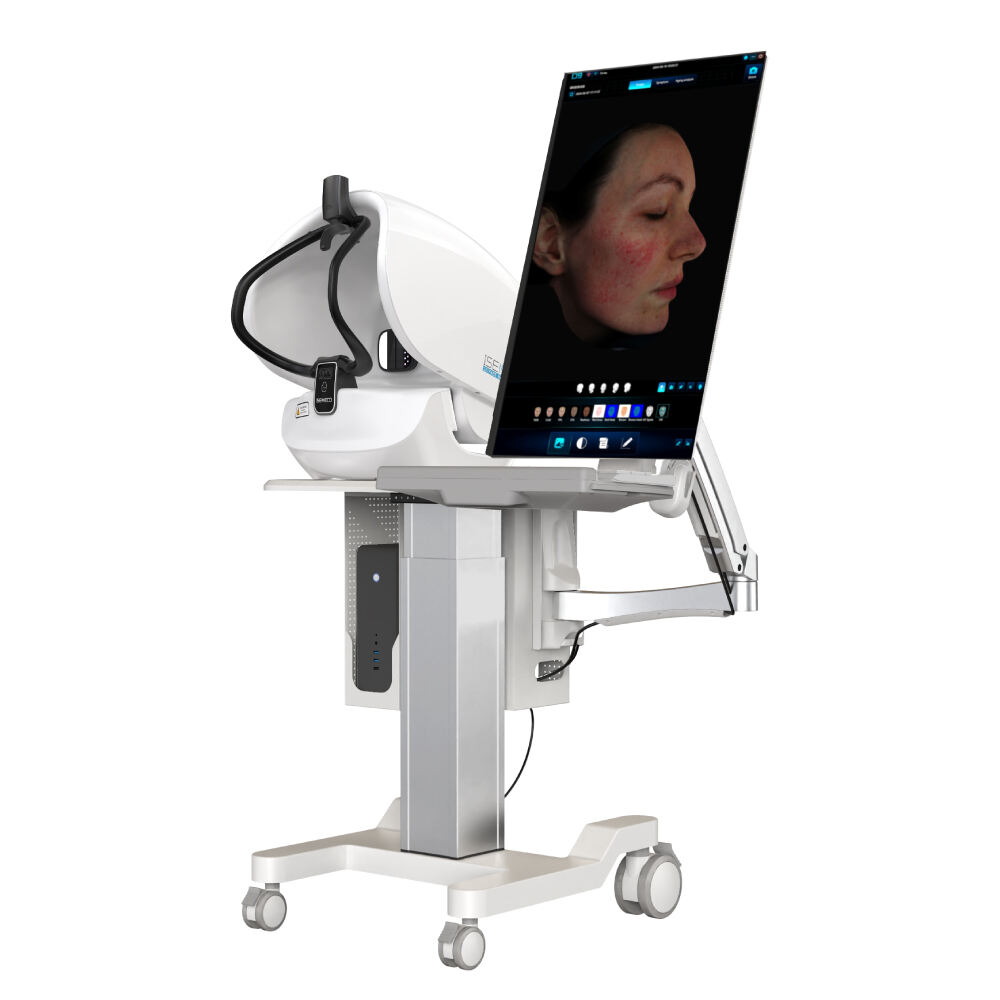
Telehealth has reshaped how healthcare is delivered, and dermatology is no exception. Today’s patients expect high-quality care regardless of location, whether they live in urban centers or rural areas. MEICET’s cloud-based skin analyzers are making this possible by integrating advanced imaging, AI diagnostics, and seamless data sharing—breaking down geographical barriers to consistent, precise skin health care.
Streamlining Remote Workflows with Cloud Technology
MEICET’s MC10 Skin Analyzer leverages cloud architecture to simplify care in decentralized practices. Here’s how it works: Nurses or technicians at satellite clinics, urgent care centers, or even patient homes can perform scans using the MC10. Results are instantly uploaded to a secure cloud portal, where dermatologists can review them from anywhere—whether they’re in a main clinic, working from home, or traveling. This eliminates the need for patients to travel long distances for initial assessments, making specialized care more accessible.
This real-time synchronization ensures continuity: A patient seen at a rural health center can have their scan reviewed by a specialist in a city, with treatment plans shared instantly. For multi-location clinics, this means unified patient records—every scan, note, and treatment update is stored in one place, so all providers have the latest information. A patient who visits a suburban clinic for a follow-up can have their new scan compared to previous ones from a downtown location, ensuring their care plan remains consistent.
Elevating Telehealth Beyond Smartphone Photos
Traditional telehealth often relies on patient-submitted photos, which can be blurry, poorly lit, or miss critical details. MEICET’s Pro-A Analyzer changes this with multi-spectral imaging designed for remote use. Patients use user-friendly, clinic-provided devices to capture UV, polarized, and visible light images of their skin. These images are analyzed by AI algorithms to detect subsurface issues—like early pigmentation, inflammation, or texture changes—that would be invisible in a standard photo.
For example, a patient with a history of sun exposure can capture a UV scan at home, revealing latent damage that a regular photo wouldn’t show. Their clinician can then recommend preventive treatments, such as antioxidant serums or targeted laser sessions, without waiting for an in-person visit. A patient managing rosacea can use the Pro-A’s polarized mode to capture images of their skin during a flare-up, allowing their clinician to adjust their medication dosage or recommend additional calming treatments—all without an office visit. This proactive approach catches issues early, improving outcomes and reducing the need for more intensive interventions later.
The Future of Remote Care: Interactive and Personalized
MEICET is expanding telehealth capabilities even further with features designed for real-time interaction. The MC88 Analyzer, for instance, supports live video consultations where clinicians can share scan results on screen, guiding patients through self-examinations or explaining how a treatment will target specific areas. A patient using a topical medication for acne can show their skin via live scan, and the clinician can adjust application instructions based on what they see—pointing out areas where coverage is insufficient or where irritation is starting to develop.
This interactive approach bridges the gap between remote and in-person care, ensuring personalized guidance. For patients with chronic conditions like eczema, regular remote scans allow clinicians to monitor skin barrier health and adjust treatments before a full flare-up occurs. Parents of children with skin issues can capture scans at home, reducing the stress of frequent clinic visits while ensuring their child’s care remains consistent.
Security and Accessibility: Cornerstones of Cloud-Based Care
MEICET’s cloud platform prioritizes both security and accessibility. Patient data is encrypted in transit and at rest, with role-based access controls ensuring only authorized providers can view sensitive information. The platform is also designed to be user-friendly, with intuitive interfaces that require minimal training—critical for rural clinics or small practices with limited IT resources.
Clinicians can access the platform from any device with an internet connection, whether a desktop computer in the office or a tablet during a home visit. This flexibility ensures that care isn’t delayed by location, and that providers can respond quickly to patient needs.
Conclusion
MEICET’s cloud-based skin analyzers are redefining remote dermatology, making high-precision care accessible to more patients than ever. By combining multi-spectral imaging, AI, and seamless data sharing, these tools ensure that distance no longer limits the quality of skin health care.
Explore how to bring this innovation to your practice. Visit www.isemeco.com today.
 EN
EN
 AR
AR
 BG
BG
 HR
HR
 CS
CS
 DA
DA
 NL
NL
 FI
FI
 FR
FR
 DE
DE
 EL
EL
 HI
HI
 IT
IT
 JA
JA
 KO
KO
 NO
NO
 PL
PL
 PT
PT
 RO
RO
 RU
RU
 ES
ES
 SV
SV
 TL
TL
 IW
IW
 ID
ID
 SR
SR
 SK
SK
 SL
SL
 UK
UK
 VI
VI
 SQ
SQ
 HU
HU
 TH
TH
 TR
TR
 FA
FA
 AF
AF
 MS
MS
 UR
UR
 BN
BN
 LA
LA

